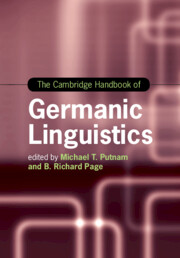Book contents
- The Cambridge Handbook of Germanic Linguistics
- Cambridge Handbooks in Language and Linguistics
- The Cambridge Handbook of Germanic Linguistics
- Copyright page
- Contents
- Figures
- Maps
- Tables
- Contributors
- Acknowledgments
- Germanic Languages
- Part I Phonology
- Part II Morphology and Agreement Systems
- Part III Syntax
- Part IV Semantics and Pragmatics
- Part V Language Contact and Nonstandard Varieties
- Chapter 29 Second Language Acquisition of Germanic Languages
- Chapter 30 Urban Speech Styles of Germanic Languages
- Chapter 31 The West Germanic Dialect Continuum
- Chapter 32 The North Germanic Dialect Continuum
- Chapter 33 Heritage Germanic Languages in North America
- Chapter 34 Minority Germanic Languages
- Chapter 35 Germanic Contact Languages
- Index
- References
Chapter 33 - Heritage Germanic Languages in North America
from Part V - Language Contact and Nonstandard Varieties
Published online by Cambridge University Press: 31 March 2020
- The Cambridge Handbook of Germanic Linguistics
- Cambridge Handbooks in Language and Linguistics
- The Cambridge Handbook of Germanic Linguistics
- Copyright page
- Contents
- Figures
- Maps
- Tables
- Contributors
- Acknowledgments
- Germanic Languages
- Part I Phonology
- Part II Morphology and Agreement Systems
- Part III Syntax
- Part IV Semantics and Pragmatics
- Part V Language Contact and Nonstandard Varieties
- Chapter 29 Second Language Acquisition of Germanic Languages
- Chapter 30 Urban Speech Styles of Germanic Languages
- Chapter 31 The West Germanic Dialect Continuum
- Chapter 32 The North Germanic Dialect Continuum
- Chapter 33 Heritage Germanic Languages in North America
- Chapter 34 Minority Germanic Languages
- Chapter 35 Germanic Contact Languages
- Index
- References
Summary
The empirical focus of this chapter are heritage Germanic languages spoken in North America. Heritage languages are the first language of individuals who speak a language at home that is not the dominant language of the larger society (pace Rothman 2009). Unlike minority languages (see Louden, Chapter 34), speakers of heritage varieties of Germanic are not tied to a particular religious group. Additionally, the majority of these heritage speakers speak moribund vernaculars. Here we review the general properties of the phonology, morphology and morpho-syntax, syntax, and semantics and pragmatics of heritage German and Norwegian. We discuss the impact that these empirical findings have on theoretical analyses, include language attrition and the potential of incomplete mastery of elements of the heritage language.
Keywords
- Type
- Chapter
- Information
- The Cambridge Handbook of Germanic Linguistics , pp. 783 - 806Publisher: Cambridge University PressPrint publication year: 2020



